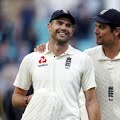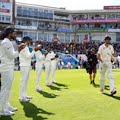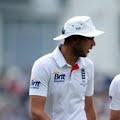When a team dominates a Test for two days, they should be mighty disappointed to lose the match in four days. This heart-breaking feeling is what Australia must be experiencing having caved in to give up their Ashes challenge on Monday. For the first two days of the Test, Australia did everything right. The bowlers did exceptionally well to dismiss England for a low score, and then Chris Rogers’ maiden century put them in a comfortable position at the end of day two. However, they failed to capitalise on the advantage. Still, Australia fought back well with the ball in the second innings as well, but their day four batting collapse meant the end of for the road for Australia in the series.
Australia should be shattered to have lost the Test by 74 runs, especially after their brave counter-attack chasing a highly challenging target of 299. David Warner made a marvelous half-century and Rogers supported him exceedingly well in a century opening stand that gave Australia more than just hope. However, what followed was highly disappointing from the visitors’ point of view. Once Rogers was sent back, they collapsed from 109 for 1 to 224 all out.
While it must be said that England bowled exceedingly well to fight back, Australia’s batsmen should have done better to stand up to the challenge. A number of their batsmen got starts, but could not carry on tomake bigger scores. Rogers made 49, and Khawaja and skipper Michael Clarke 21 each. Had at least one of them made a significant score, like Warner’s 71, Australia could still have achieved the target. After all, they fell 74 runs short of the target, which means had any one of the other Aussie batsmen come up with a half-century, things would have got extremely close.
 Apart from the batting collapse on the fourth and last day of the Test, there were a number of key moments which Australia lost that cost them the game. Having cleaned up England for a paltry 238 in the first innings, Australia were in a position to build a substantial lead courtesy Rogers’ maiden century. However, their lower order batting faltered, and then ended up with a negligible lead of 32. Then, after having Englishmen tottering at 49 for 3 in the second innings, the Aussie bowlers allowed England to recover to 330, which meant the visitors had to chase a difficult 299.
Apart from the batting collapse on the fourth and last day of the Test, there were a number of key moments which Australia lost that cost them the game. Having cleaned up England for a paltry 238 in the first innings, Australia were in a position to build a substantial lead courtesy Rogers’ maiden century. However, their lower order batting faltered, and then ended up with a negligible lead of 32. Then, after having Englishmen tottering at 49 for 3 in the second innings, the Aussie bowlers allowed England to recover to 330, which meant the visitors had to chase a difficult 299.
England, on the other hand, fought back every time they were in trouble. Stuart Broad has his best Test match with the ball, grabbing wickets every time England needed them. His 11-wicket match haul was the most significant performance of the match. Ian Bell’s hundred was also equally important. It came at a stage where England were desperate for a big knock from someone having lost quick wickets. And who better than Bell on current form? Early on day four, Australia had a chance to clean up England’s tail quickly. Instead, Bresnan and Swann played two breezy cameos, which took England to what turned out to be match-winning total.
--By A Cricket Analyst














